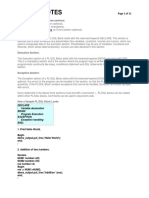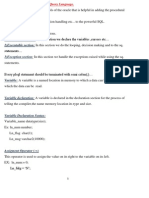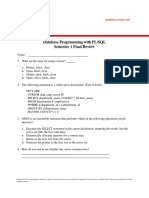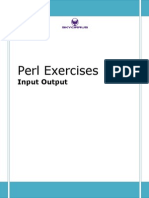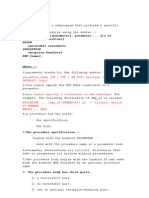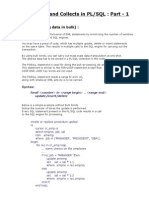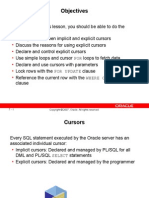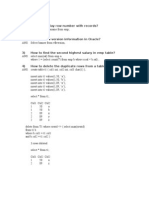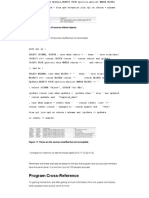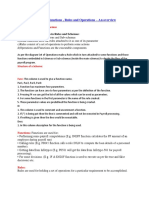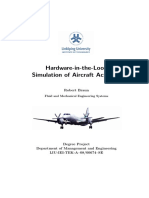Introduction To REF CURSOR
Introduction To REF CURSOR
Uploaded by
ftazyeenCopyright:
Available Formats
Introduction To REF CURSOR
Introduction To REF CURSOR
Uploaded by
ftazyeenOriginal Title
Copyright
Available Formats
Share this document
Did you find this document useful?
Is this content inappropriate?
Copyright:
Available Formats
Introduction To REF CURSOR
Introduction To REF CURSOR
Uploaded by
ftazyeenCopyright:
Available Formats
All the examples in this series have been tested only with Oracle 10g (V10.2).
I didn't really test any of the examples in any of the previous versions. If you have any problems during the execution of these examples, please post in the discussion area. Introduction to REF CURSOR A REF CURSOR is basically a data type. A variable created based on such a data type is generally called a cursor variable. A cursor variable can be associated with different queries at run-time. The primary advantage of using cursor variables is their capability to pass result sets between sub programs (like stored procedures, functions, packages etc.). Let us start with a small sub-program as follows: declare type r_cursor is REF CURSOR; c_emp r_cursor; en emp.ename%type; begin open c_emp for select ename from emp; loop fetch c_emp into en; exit when c_emp%notfound; dbms_output.put_line(en); end loop; close c_emp; end; Let me explain step by step. The following is the first statement you need to understand: type r_cursor is REF CURSOR; The above statement simply defines a new data type called "r_cursor," which is of the type REF CURSOR. We declare a cursor variable named "c_emp" based on the type "r_cursor" as follows: c_emp r_cursor;
Every cursor variable must be opened with an associated SELECT statement as follows: open c_emp for select ename from emp; To retrieve each row of information from the cursor, I used a loop together with a FETCH statement as follows: loop fetch c_emp into en; exit when c_emp%notfound; dbms_output.put_line(en); end loop; I finally closed the cursor using the following statement: close c_emp; %ROWTYPE with REF CURSOR In the previous section, I retrieved only one column (ename) of information using REF CURSOR. Now I would like to retrieve more than one column (or entire row) of information using the same. Let us consider the following example: declare type r_cursor is REF CURSOR; c_emp r_cursor; er emp%rowtype; begin open c_emp for select * from emp; loop fetch c_emp into er; exit when c_emp%notfound; dbms_output.put_line(er.ename || ' - ' || er.sal); end loop; close c_emp; end; In the above example, the only crucial declaration is the following: er emp%rowtype;
The above declares a variable named "er," which can hold an entire row from the "emp" table. To retrieve the values (of each column) from that variable, we use the dot notation as follows: dbms_output.put_line(er.ename || ' - ' || er.sal); Let us consider that a table contains forty columns and I would like to retrieve fifteen columns. In such scenarios, it is a bad idea to retrieve all forty columns of information. At the same time, declaring and working with fifteen variables would be bit clumsy. The next section will explain how to solve such issues. Next: Working with REC
TOOLS YOU CAN USE
advertisement
See Also:
1. 2. 3. Oracle Stored Procedures Extending PL/SQL with Java Libraries, concluded Oracle PL/SQL Subprograms
Until now, we have been working either with %TYPE or %ROWTYPE. This means we are working with either one value or one complete record. How do we create our own data type, with our own specified number of values to hold? This is where TYPE and RECORD come in. Let us consider the following example: declare type r_cursor is REF CURSOR; c_emp r_cursor; type rec_emp is record ( name varchar2(20), sal number(6) ); er rec_emp;
begin open c_emp for select ename,sal from emp; loop fetch c_emp into er; exit when c_emp%notfound; dbms_output.put_line(er.name || ' - ' || er.sal); end loop; close c_emp; end; The most confusing aspect from the above program is the following: type rec_emp is record ( name varchar2(20), sal number(6) ); The above defines a new data type named "rec_emp" (just like %ROWTYPE with limited specified fields) which can hold two fields, namely "name" and "sal." er rec_emp; The above statement declares a variable "er" based on the datatype "rec_emp." This means that "er" internally contains the fields "name" and "job." fetch c_emp into er; The above statement pulls out a row of information (in this case "ename" and "sal") and places the same into the fields "name" and "sal" of the variable "er." Finally, I display both of those values using the following statement: dbms_output.put_line(er.name || ' - ' || er.sal); Next: Working with more than one query wit
Sub-programs can also be called sub-routines. These are nothing but the divisions of the main program. These divisions are named and are executed when they are called by name from the main program. They will not get executed unless they are called. The following is an example: declare type r_cursor is REF CURSOR; c_emp r_cursor; type rec_emp is record ( name varchar2(20), sal number(6) ); er rec_emp; procedure PrintEmployeeDetails is begin loop fetch c_emp into er; exit when c_emp%notfound; dbms_output.put_line(er.name || ' - ' || er.sal); end loop; end; begin for i in (select deptno,dname from dept) loop open c_emp for select ename,sal from emp where deptno = i.deptno; dbms_output.put_line(i.dname); dbms_output.put_line('--------------'); PrintEmployeeDetails; close c_emp; end loop; end; In the above program, the sub-routine is named "PrintEmployeeDetails." You can observe that I am executing (or calling) the sub-routine from within the loop as follows:
for i in (select deptno,dname from dept) loop . . PrintEmployeeDetails; . . end loop; According to the above loop, the sub-routine gets executed for every iteration, which displays the employee information for the respective department. Passing REF CURSOR as parameters to sub-programs In the previous section, we already started working with subprograms (or sub-routines). In this section, I shall extend the same with the concept of "parameters" (or arguments). Every subprogram (or sub-routine) can accept values passed to it in the form of "parameters" (or arguments). Every parameter is very similar to a variable, but gets declared as part of a sub-program. Let us consider the following program: declare type r_cursor is REF CURSOR; c_emp r_cursor; type rec_emp is record ( name varchar2(20), sal number(6) ); procedure PrintEmployeeDetails(p_emp r_cursor) is er rec_emp; begin loop fetch p_emp into er; exit when p_emp%notfound; dbms_output.put_line(er.name || ' - ' || er.sal); end loop; end;
begin for i in (select deptno,dname from dept) loop open c_emp for select ename,sal from emp where deptno = i.deptno; dbms_output.put_line(i.dname); dbms_output.put_line('--------------'); PrintEmployeeDetails(c_emp); close c_emp; end loop; end; From the above program, you can observe the following declaration: procedure PrintEmployeeDetails(p_emp r_cursor) is In the above declaration, "PrintEmployeeDetails" is the name of the sub-routine which accepts "p_emp" as a parameter (of type "r_cursor") and we can use that parameter throughout that subroutine. I hope you enjoyed the article and any comments, suggestions, feedback, bugs, errors, enhancements etc. are highly appreciated at http://jagchat.spaces.live.com
>>> More Oracle Articles
>>> More By Jagadish Chatarji
Disqus
Like
Dislike 16 people liked this. Login
Add New Comment
Post as Image
Sort by popular now
Showing 96 comments
Raj Kannan79
I can understand the program. I don't know where to use this refcursor in program
o o o o o Shivakumar241988
Like Reply 4 months ago 3 Likes
Really this was helpfull.
o o o o o Anonymous2404
Like Reply 6 months ago 2 Likes
Really awesome. This article is simple, straight forward which can be understandable by all. Thanks for your article.
o o o o o
Like Reply 8 months ago 2 Likes
Anonymous1134
Not very informative, U r not explaining the power of ref cursor. It's more of an example of Cursor fetch rather than Ref cursor. You should have included examples of Weak and Strong Ref cursors.
o o o o o Anonymous1844
Like Reply 9 months ago 2 Likes
CREATE OR REPLACE PROCEDURE REF_CURSOR(TABLE_NAME IN VARCHAR) IS type t is ref cursor; c t; v_dept dept%rowtype; type r is record(ename emp.ename%type,job emp.job%type,sal emp.sal%type); v_emp r; v_stud student.name%type; BEGIN if table_name = 'DEPT' then open c for select * from dept; elsif table_name = 'EMP' then open c for select ename,job,sal from emp; elsif table_name = 'STUDENT' then
open c for select name from student; end if; loop if table_name = 'DEPT' then fetch c into v_dept; exit when c%notfound; dbms_output.put_line('Deptno = ' || v_dept.deptno || ' Dname = ' || v_dept.dname || ' Loc = ' || v_dept.loc); elsif table_name = 'EMP' then fetch c into v_emp; exit when c%notfound; dbms_output.put_line('Ename = ' || v_emp.ename || ' Job = ' || v_emp.job || ' Sal = ' || v_emp.sal); elsif table_name = 'STUDENT' then fetch c into v_stud; exit when c%notfound; dbms_output.put_line('Name = ' || v_stud); end if; end loop; close c; END;
You might also like
- Database Programming With PL/SQL Semester 1 Final ReviewDocument13 pagesDatabase Programming With PL/SQL Semester 1 Final ReviewKady Gisselle Goméz100% (1)
- 12 PLSQLIntroDocument16 pages12 PLSQLIntroapi-3827483No ratings yet
- Storage Classes in PL1Document12 pagesStorage Classes in PL1Shaswata Choudhury100% (1)
- Fundamentals of Programming Teaching GuideDocument9 pagesFundamentals of Programming Teaching GuideAmna Manzoor100% (1)
- ABB Robot Studio Installation RequirementsDocument50 pagesABB Robot Studio Installation RequirementsK Vinoth ShivanNo ratings yet
- Unit-3 PL SQL-newDocument112 pagesUnit-3 PL SQL-newmickeyhbkNo ratings yet
- 13 Cursors ExceptionDocument16 pages13 Cursors Exceptionapi-3827483No ratings yet
- Write and Execute PL-SQL Functions and Procedure ProgramsDocument11 pagesWrite and Execute PL-SQL Functions and Procedure ProgramsJohn SinghNo ratings yet
- A Ref Cursor Is A VariableDocument3 pagesA Ref Cursor Is A Variablerajeswar9No ratings yet
- 12 Tics Practices Interacting With Databases Key 1Document3 pages12 Tics Practices Interacting With Databases Key 1Akansha SaxenaNo ratings yet
- PL/SQL CursorsDocument14 pagesPL/SQL CursorsRahul PatelNo ratings yet
- Assignment 3 - PLSQLDocument4 pagesAssignment 3 - PLSQLAbhinav JaiswalNo ratings yet
- Basic PL SQL Notes For StudentsDocument11 pagesBasic PL SQL Notes For StudentsAzmath Tech TutsNo ratings yet
- CURSORSDocument42 pagesCURSORSs g shrinivasNo ratings yet
- Oracle PLSQL and SQLDocument7 pagesOracle PLSQL and SQLVenkatesanNo ratings yet
- PLSQL Complete ReferenceDocument92 pagesPLSQL Complete ReferenceChaitanya SagarNo ratings yet
- Bulk CollectDocument5 pagesBulk CollectAbhishekNo ratings yet
- PLSQL - Cursor Online Session Notes PDFDocument35 pagesPLSQL - Cursor Online Session Notes PDFsarala deviNo ratings yet
- Oracle 10g Cursor ConceptsDocument11 pagesOracle 10g Cursor ConceptsSelvaraj V100% (1)
- PLSQL Semester 1 Final Review PDFDocument15 pagesPLSQL Semester 1 Final Review PDFСемён Рожков0% (1)
- PLSQL - 5 - 2 - Brayan Ferney Perez Moreno PDFDocument3 pagesPLSQL - 5 - 2 - Brayan Ferney Perez Moreno PDFBryan Perez100% (2)
- Ref Cursor ExamplesDocument17 pagesRef Cursor ExamplesjeeendraNo ratings yet
- PLSQL NotesDocument78 pagesPLSQL NotesRaghavendra PrabhuNo ratings yet
- PLSQL NotesDocument19 pagesPLSQL NotesKumar RajNo ratings yet
- Cursor ExamplesDocument12 pagesCursor ExamplesAnonymous gU7fu7pKrNo ratings yet
- Input Output PerlDocument13 pagesInput Output Perlsreenivas_enishettyNo ratings yet
- 21 PLSQLDocument49 pages21 PLSQLvenkata satishNo ratings yet
- Autonomous TransactionsDocument9 pagesAutonomous TransactionsdkmdipeshNo ratings yet
- 1.creating Cursor: This Step Allocates Memory: Types of CursorsDocument7 pages1.creating Cursor: This Step Allocates Memory: Types of Cursors1raju1234No ratings yet
- PROCEDURE Name ( (Parameter (, Parameter, ... ) ) ) IS (Local Declarations) Begin Executable Statements (Exception Exception Handlers) END (Name)Document34 pagesPROCEDURE Name ( (Parameter (, Parameter, ... ) ) ) IS (Local Declarations) Begin Executable Statements (Exception Exception Handlers) END (Name)api-3831209100% (1)
- Pls QL NotesDocument9 pagesPls QL NotesPraful PundeNo ratings yet
- CursorsDocument7 pagesCursorsRobert BaciuNo ratings yet
- PL SQL K Online MaterialDocument98 pagesPL SQL K Online MaterialSalai Sukumar80% (5)
- Bulk Binds and Collects in PLSQLDocument6 pagesBulk Binds and Collects in PLSQLsagarka21No ratings yet
- PLSQL Semester 1 Final ReviewDocument12 pagesPLSQL Semester 1 Final Reviewfleur d'automne clairNo ratings yet
- WWW - Yagc.ndo - Co.uk Cheatsheets PLSQL Cheatsheet - HTMLDocument3 pagesWWW - Yagc.ndo - Co.uk Cheatsheets PLSQL Cheatsheet - HTMLjeevithamanteNo ratings yet
- 5-Using Explicit CursorsDocument24 pages5-Using Explicit CursorsasifsubhanNo ratings yet
- Update Emp Set Sal Sal+sal 0.15 Where Empno &empno If Sql%found Then Dbms - Output - Put - Line ( Employee Record Modified')Document11 pagesUpdate Emp Set Sal Sal+sal 0.15 Where Empno &empno If Sql%found Then Dbms - Output - Put - Line ( Employee Record Modified')arvi.sardarNo ratings yet
- Zeba Cursors1Document5 pagesZeba Cursors1nagarajuvcc123No ratings yet
- RPGLEDocument29 pagesRPGLESai Dinesh100% (1)
- Interview QuestionsDocument12 pagesInterview QuestionsAli NaveedNo ratings yet
- Customizing SAP-ABAP For DummiesDocument17 pagesCustomizing SAP-ABAP For DummiestngongomaNo ratings yet
- TechTip - Analyze Your Programs and Applications, Part II - System Administration - IT Infrastructure 3Document6 pagesTechTip - Analyze Your Programs and Applications, Part II - System Administration - IT Infrastructure 3Johnny SaysBlowmeNo ratings yet
- PLSQLDocument196 pagesPLSQLanugula ramNo ratings yet
- Aula 03 Exerc CursoresDocument10 pagesAula 03 Exerc CursoresJeanNunesNo ratings yet
- Interview QuestionsDocument164 pagesInterview QuestionsKapil Sharma100% (1)
- PLSQLDocument142 pagesPLSQLCutenag IndiaNo ratings yet
- 1.what Is A Cursor For Loop ?Document15 pages1.what Is A Cursor For Loop ?animesh_banik1No ratings yet
- Oracle NotesDocument64 pagesOracle NotesRaghavendra PrabhuNo ratings yet
- PL/SQL Tutorial (Examples) - Page 3 PL/SQL BlockDocument21 pagesPL/SQL Tutorial (Examples) - Page 3 PL/SQL BlockSabari NathanNo ratings yet
- PLSQL PresentationDocument65 pagesPLSQL PresentationSethu Lakshmi SNo ratings yet
- Ref Cursor Strong WeakDocument7 pagesRef Cursor Strong Weakdipson234No ratings yet
- ASP TutorialDocument19 pagesASP Tutorialrahuls256No ratings yet
- PLSQL Course WareDocument135 pagesPLSQL Course Warenaga5825No ratings yet
- x64 AsmDocument4 pagesx64 Asmasdmin100% (1)
- PL SQL Session3 Record Table CursorDocument42 pagesPL SQL Session3 Record Table CursorKollu ThrailokyaNo ratings yet
- Control Structures Conditional Statements:-: ExamplesDocument16 pagesControl Structures Conditional Statements:-: ExamplesMohd Imran AhmedNo ratings yet
- PL-SQL - Part2: Exception Handling Procedure Function Cursors TriggerDocument80 pagesPL-SQL - Part2: Exception Handling Procedure Function Cursors TriggerKARTIKAY LADDHANo ratings yet
- Programs On CursorsDocument7 pagesPrograms On Cursorspriyanka tataNo ratings yet
- PLSQL & Relational AlgebraDocument21 pagesPLSQL & Relational AlgebraSwathi GR Swathi GRNo ratings yet
- PLSQL ProgramsDocument11 pagesPLSQL ProgramsAnuj SinghNo ratings yet
- What Is PL/SQL?: PL/SQL Stands For Procedural Language Extension of SQLDocument25 pagesWhat Is PL/SQL?: PL/SQL Stands For Procedural Language Extension of SQLRan ReddyNo ratings yet
- Project Cost ForecastDocument11 pagesProject Cost ForecastJames MendesNo ratings yet
- CAM350 Ver.10 Macro ManualDocument390 pagesCAM350 Ver.10 Macro Manualgeppetto48No ratings yet
- Career Hackers: Hack Your Career Today Python in FinanceDocument26 pagesCareer Hackers: Hack Your Career Today Python in FinanceTrieu Nam100% (1)
- Ethereum Development With Go PDFDocument154 pagesEthereum Development With Go PDFaldhibahNo ratings yet
- Sap Payrolls ChemaDocument17 pagesSap Payrolls Chemaclaoker100% (2)
- Ebooks For Jntu Subjects: 2007-2008Document102 pagesEbooks For Jntu Subjects: 2007-2008Srinivas RaoNo ratings yet
- PPL Record - Mohamed Shalin, Cse, 17 Veltech, ChennaiDocument86 pagesPPL Record - Mohamed Shalin, Cse, 17 Veltech, Chennairishika saiNo ratings yet
- 2 MARKS OopsDocument22 pages2 MARKS OopsNatarajanBalasubramaniyan100% (1)
- 2013-14 I B.Tech-I Sem: S.no Unit Topic Contents To Be Covered Objective ApplicationDocument20 pages2013-14 I B.Tech-I Sem: S.no Unit Topic Contents To Be Covered Objective Applicationgdayanand4uNo ratings yet
- Self-Quiz Unit 2 - Attempt ReviewDocument8 pagesSelf-Quiz Unit 2 - Attempt ReviewDr TechNo ratings yet
- Hardware-in-the-Loop Simulation of Aircraft Actuator: Robert BraunDocument72 pagesHardware-in-the-Loop Simulation of Aircraft Actuator: Robert BraunRedkit ofFootHillNo ratings yet
- JavaScript FundamentalsDocument75 pagesJavaScript FundamentalsantonyNo ratings yet
- Concepts: What Are Acronyms BDC, BI, BTC, BTCI, CTU, LSMW?Document12 pagesConcepts: What Are Acronyms BDC, BI, BTC, BTCI, CTU, LSMW?Chris BaileyNo ratings yet
- GMWIN Manual (2000.09.29) (Eng)Document287 pagesGMWIN Manual (2000.09.29) (Eng)Okta JuniorNo ratings yet
- Adit Lab B2 Chap4Document37 pagesAdit Lab B2 Chap4Madhav Reddy ChintapalliNo ratings yet
- Python and Automation by NitikeshDocument15 pagesPython and Automation by NitikeshvinayNo ratings yet
- Section 2 - Quiz 1 L1-L7Document18 pagesSection 2 - Quiz 1 L1-L7Anonymous kMBVtf7xKD57% (7)
- Symfony Best Practices 4.2Document40 pagesSymfony Best Practices 4.2Wijdane AoufiNo ratings yet
- Universe Pick BasicDocument306 pagesUniverse Pick Basiclukerathbun100% (1)
- Visual Foxpro 5.0+ FTP Service Class: DisclaimerDocument14 pagesVisual Foxpro 5.0+ FTP Service Class: DisclaimerJoseph ChircopNo ratings yet
- 1st Quarter Test Etech 11Document2 pages1st Quarter Test Etech 11Rowena GonzalesNo ratings yet
- Python and LibreOffice TemplateDocument32 pagesPython and LibreOffice TemplatedchirinoNo ratings yet
- CBCDocument73 pagesCBCMichael B. Silva100% (3)
- A Little C PrimerDocument36 pagesA Little C PrimerAditya BhuyanNo ratings yet
- F Capacitor, Find The Appropriate Value ofDocument2 pagesF Capacitor, Find The Appropriate Value ofJoginder YadavNo ratings yet
- Unit - I History of PHP: ReleasedDocument44 pagesUnit - I History of PHP: ReleasedmdfayasnNo ratings yet
- SQL Server Stored ProceduresDocument7 pagesSQL Server Stored Procedureshkdashin100% (1)












